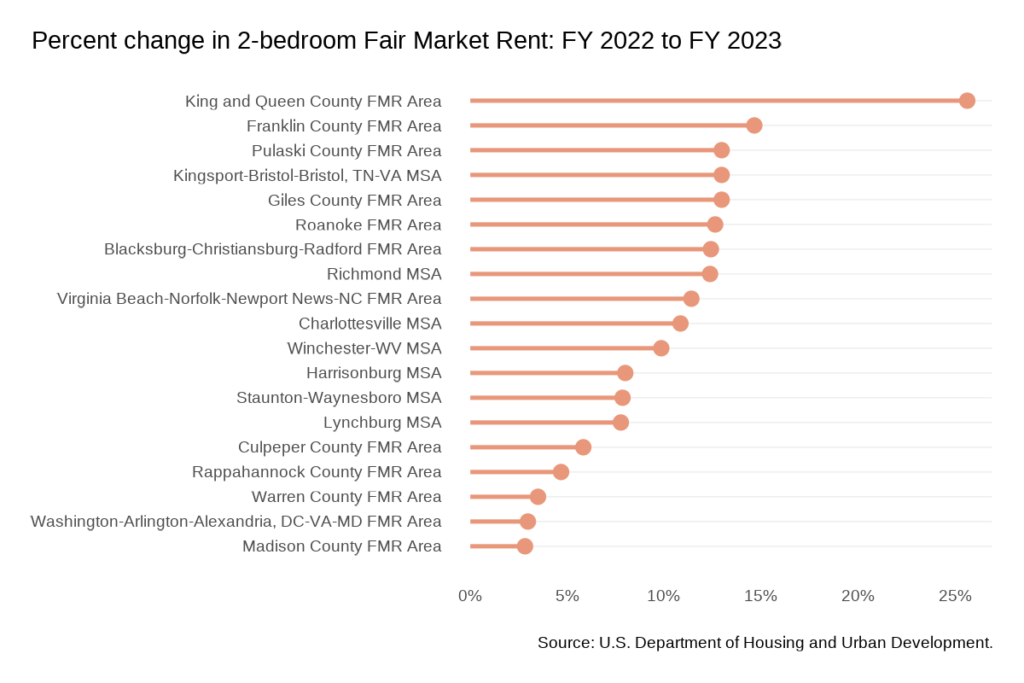The FWD #B08 • 731 Words
Fair Market Rents are a crucial part of our affordable housing system, but don’t always give tenants a fair shake.
Earlier this month, HUD released new Fair Market Rents (FMRs) for FY 2023. This year’s edition is notable for a number of reasons, but most importantly for the significant increases from FY 2022. Traditionally, FMRs have seen annual increases of a few percent. This time, they went up an average of 10 percent across the nation.
Here in Virginia, some of the biggest spikes were in counties and small metro areas in the Southwest. The Richmond, Hampton Roads, and Charlottesville regions also saw increases over 10 percent. But King and Queen County, home to just over 7,000 people, blew past everyone with an increase over 25 percent.

While some of you may have eagerly awaited this announcement, there are probably more than a few of you wondering what FMRs are and why HUD is even in the business of setting rents. We’ll do our best to answer those questions in this edition of Back to Basics.
What are Fair Market Rents?
Fair Market Rents are the official values HUD sets to determine payment standard amounts for Housing Choice Vouchers and other housing assistance programs. Separate rates are provided for studios (no bedroom) and apartments with one, two, three, and four bedrooms.
For example, the FY 2023 FMR for a two-bedroom apartment in Charlottesville is $1,401. If a tenant with a HCV can affordably pay $700 for housing, then the amount covered by the voucher is $701.
FMRs for 2023—and previous years—are available using the query tool on HUD’s website.
How are FMRs calculated?
FMRs are the 40th percentile rents paid by renters who have moved in the past two years. This means FMRs are slightly below the median (50th percentile) rent paid by tenants with relatively new leases.
To get these figures, HUD starts with two-bedroom “base rents” pulled from the latest 5-year American Community Survey (ACS) estimates. This year, those are for the 2016-2020 period. Since that data lags by more than a year, HUD adjusts the base rents by:
- Applying a Recent Mover Factor using the latest 1-year ACS estimates to better match rents set by newer leases,
- Adjusting for inflation using the Consumer Price Index (CPI), and
- Further adjusting for inflation using a forecast of the CPI through the applicable fiscal year.
The Census Bureau suppressed the 2020 1-year ACS estimates due to low response rates during COVID-19. As a result, HUD used an array of private rent data sources to adjust the base FMRs for FY 2023, including CoStar, Moody’s Analytics, and Zillow. This change in methodology was temporary and will not be used in subsequent years.
Finally, HUD will calculate and apply “bedroom ratios” to determine FMRs for studio apartments and those with three and four bedrooms. FMRs for units with five or more bedrooms are calculated by adding 15 percent onto the four-bedroom FMR for each additional bedroom.
Why do FMRs matter?
More than 48,000 renter households in Virginia depend on HCVs to pay a portion of their rent. Tens of thousands of others live in project-based Section 8 apartments, HOME-funded rentals, and other federally assisted units that also use FMRs to set tenant payments.
FMRs set an effective upper limit on the rents HCV holders can afford. As rents have significantly accelerated in recent years, voucher recipients have struggled to find apartments with rents at or below FMR.
From June 2019 to June 2022, the number of “vouchers on the street” in Virginia—where a family has a voucher but has not secured a lease—increased from 932 to 2,452. Hopefully, the newest FMRs better reflect current market conditions and will help many of these recipients hang onto their voucher and secure an affordable home.
Detailed metrics on HCV leasing, utilization, and payment trends are available on HUD’s Housing Choice Voucher Data Dashboard. As of September 2022, the latest data are for June 2022.
What about Small Area FMRs?
Small Area FMRs (SAFMRs) set rent values by ZIP code rather than by region or locality to better reflect differences across submarkets. SAFMRs have the potential to unlock previously unaffordable neighborhoods to HCV recipients.
There’s more wonky policy—and math!—involved than we can reasonably go into here, so keep an eye out for another Back to Basics on this topic in the future.
